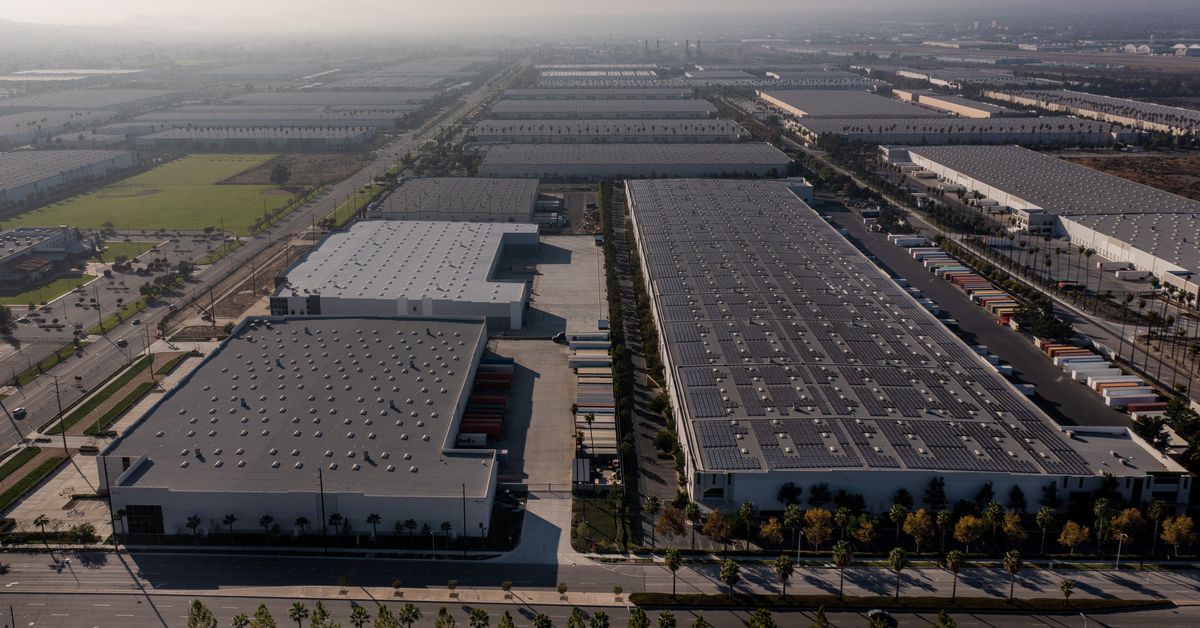
Warehouses are increasingly dominating the commercial building landscape in the US, which could have ramifications for efforts to tackle climate change. According to data recently released by the US Energy Information Administration (EIA), warehouses and storage units have become the most common commercial buildings in the country — outpacing offices. That has the potential to cause greenhouse gas emissions to climb or tumble, and it largely hinges on whether warehouses can ditch natural gas.
Compared to office buildings, warehouses that store everything from food to clothes tend to rely more heavily on gas heating systems because upfront costs of those systems are cheap, and they’re easy to install, an expert tells The Verge.Even though warehouses typically use less energy than offices, there’s a risk that their reliance on gas could increase the share of emissions coming from commercial buildings, which are already responsible for 16 percent of the country’s greenhouse gas pollution. For the Biden administration to reach its goal of halving America’splanet-heating carbon pollution compared to 2005 levels by 2030, it’ll have to work to clean up warehouse operations.
“If the building sector itself has moved, that means our strategy has to be adapted,” says Bing Liu, building subsector leader at the Pacific Northwest National Laboratory. “If you look at space heating energy use, because [warehouses use] less efficient technologies, it’s actually concerning.”
E-commerce has fueled the boom in warehouses. Online retail giants like Amazon use massive distribution centers to sort and send out their goods. Every $1 billion in online sales generates 1.25 million square feet of warehouse space demand, according to commercial real estate firm CBRE. The square footage of storage spaces in the US has ballooned from just over 10 billion square feet in 1999 to roughly 17 billion square feet in 2018 (the most recent year for which the EIA has data). That’s more floorspace than more than 295,000 football fields would cover.
While we don’t have data yet from the EIA beyond 2018, the pandemic has driven up demand for warehouse space even further. Online shopping became even more popular. And with consumers still demanding quick deliveries despite kinks in supply chains, retailers are increasingly storing excess inventory in warehouses. At the same time, demand for retail and office space has taken a hit during the pandemic because of remote work.
There is a lot of room for warehouses to improve when it comes to their impact on the environment. Liu says warehouse developers can take the lead of office buildings that have been quicker to electrify and switch from natural gas heating systems over to electricheat pumps. Some climate-conscious cities, starting with Berkeley, California, in the US, have moved to ban natural gas hook-ups in new construction — efforts that the gas industry is trying to derail.
Other trends could make pollution from warehouses’ gas heating a bigger problem. A lot of e-commerce warehouses are clustered in sunny Southern California, where Amazon sends much of its imported goods. But there’s recently been more warehouse growth in colder regions in the midwest — which raises the urgency for transitioning warehouses to cleaner heating, according to Liu. On top of that, warehouses tend to be less insulated against the elements than office buildings.And as the Biden administration moves to keep ports open 24/7 to ease supply chain backlogs, that might mean bigger heating bills for warehouses because of longer operating hours stretching into colder evenings.
On the other hand, if warehouses sort out the heating issue, their rising popularity could potentially drive down greenhouse gas emissions for the commercial building sector. Unrefrigerated warehouses, which make up the biggest chunk of storage buildings, typically use less than half as much energy per square foot compared with office buildings, according to the EIA. That’s because there aren’t so many computers to keep running or people to keep comfortable with air conditioning and hot water. Ultimately, having a larger share of less energy-intensive buildings like warehouses “has the potential to bring down total commercial energy use,” Zack Marohl, an economist at the EIA, told The Verge in an email.
There are, of course, other environmental issues to tackle with warehouses. Building materials and construction are responsible for about 10 percent of global greenhouse gas emissions, so Liu says finding sustainable alternatives to materials like cement should be a priority this decade. What’s more, warehouses can be magnets for tailpipe pollution from diesel trucks — which can pose health threats to nearby neighborhoods. That only underscores the extra benefits turning to clean energy can have.
"gas" - Google News
December 04, 2021 at 02:36AM
https://ift.tt/3oiygco
As warehouses take off, they need to kick natural gas - The Verge
"gas" - Google News
https://ift.tt/2LxAFvS
https://ift.tt/3fcD5NP
Bagikan Berita Ini














0 Response to "As warehouses take off, they need to kick natural gas - The Verge"
Post a Comment